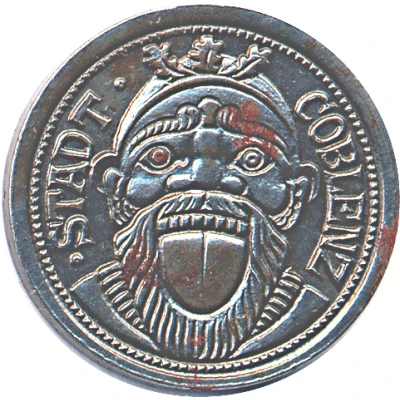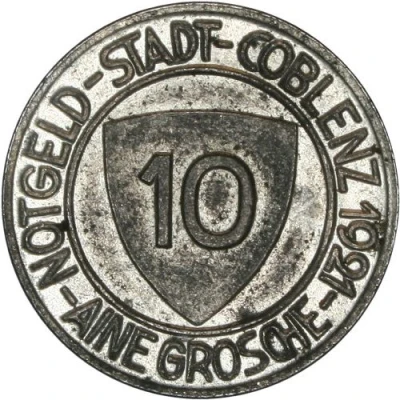


© Teutoburger Münzauktion
10 Pfennigs - Coblenz
1920 year| Iron | - | 19.8 mm |
| Issuer | City of Koblenz (Prussian province of Rhine) |
|---|---|
| Period | Weimar Republic (1918-1933) |
| Type | Standard circulation coin |
| Year | 1920 |
| Value | 10 Pfennigs (10 Pfennige) (0.10) |
| Currency | Mark (1914-1924) |
| Composition | Iron |
| Diameter | 19.8 mm |
| Shape | Round |
| Technique | Milled |
| Orientation | Medal alignment ↑↑ |
| Demonetized | Yes |
| Updated | 2024-10-04 |
| Numista | N#299504 |
|---|---|
| Rarity index | 93% |
Reverse
Script: Latin
Lettering:
NOTGELD
10
✶ PFENNIG ✶
Edge
Plain
Comment
https://www.numisbids.com/n.php?p=lot&sid=1854&lot=2693Interesting fact
The 10 Pfennigs - Coblenz 1920 coin was minted during a time of economic turmoil in Germany, known as the "Inflationary Period" (1914-1923). During this time, the value of the German mark plummeted, and the cost of living skyrocketed. As a result, the government was forced to print more and more money to keep up with the increasing prices, leading to a massive inflation of the currency. The 10 Pfennigs - Coblenz 1920 coin, made of iron, was one of the many coins minted during this time as a response to the economic crisis. It's interesting to note that the coin's value was not only affected by the economic situation but also by the political changes happening in Germany at the time. The coin was minted during the Weimar Republic, a time of political instability and social unrest, which ultimately led to the rise of the Nazi Party and the fall of the Weimar Republic. Overall, the 10 Pfennigs - Coblenz 1920 coin is a fascinating piece of history that not only tells a story of economic hardship but also reflects the political and social changes happening in Germany during that time.



